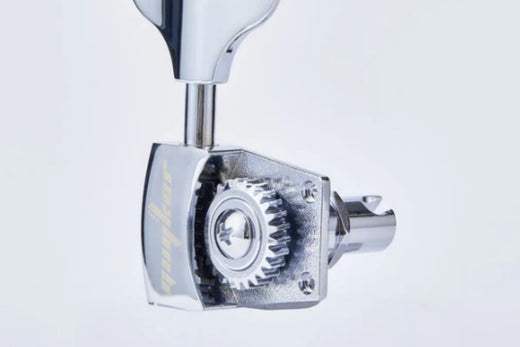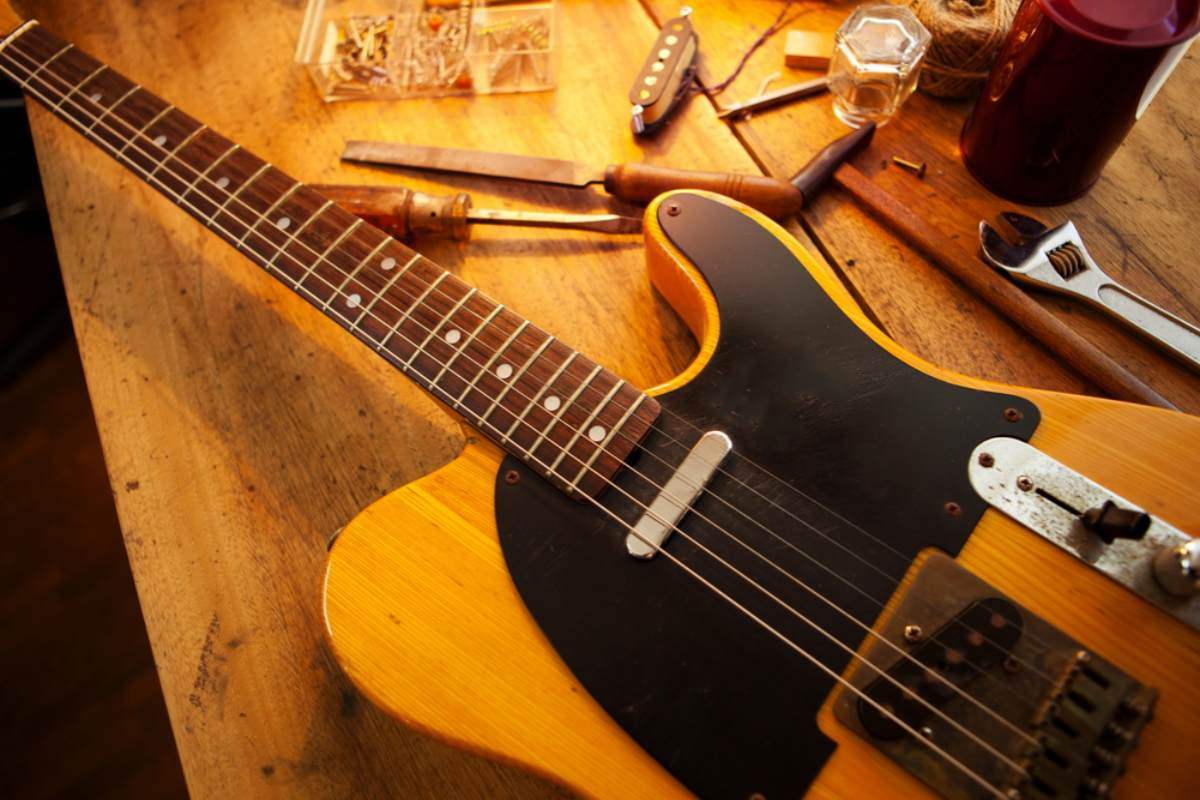Once you jump on the other side of the counter and understand how an electric guitar is made, you see the instrument differently. Yes, when you know nothing about guitars, you see flashy colors, beautiful lines, and countless potential songs.
Soon, you learn to differentiate Koa from poplar, humbuckers from single coils, and Floyd Roses from Bigsby tremolos.
But is the price of a guitar just the sum of its parts? We’re about to dig deep into this topic and shed some light on what makes electric guitar prices. Hopefully, we’ll answer that question and many more along the way.
Let’s Talk Woods & Wood Selection
To begin with, the main element an electric guitar is made of comes from the lumber shop. Yes, 90% (or more) guitars are made of wood. These can be as precious as rosewood or as common as pine.
But before we talk about specific types of wood, let’s talk about guitar construction techniques. They can be made of a single piece, two pieces, or laminated.
Laminated Wood
This is the cheapest production process of the three. To make a laminated guitar, companies glue together many small pieces of wood to make a new stiff piece. Then, that’s cut into the shape of a guitar.
As you might imagine, the little pieces of different types of wood don’t vibrate evenly. When compared to a single-piece or two-piece guitar there’s a big difference in resonance, sustain, and ultimately playability and tone.
Multiple Pieces
Once you move up from the lowest tiers, most brands utilize up to 5 pieces to make their guitars. This is evident if you look at the guitar under the light. You can easily spot the places where the pieces were glued together.
Fender Mexico and Epiphone guitars fall in this category. In case you didn’t know, Epiphone Les Paul guitars feature a veneer that looks like flame maple on the top and another that looks like solid mahogany on the bottom.
This is done, among other things, to cover up the joints of the various pieces these guitars are made with.
One or Two Pieces
If you think about how thick an electric guitar body is, you instantly realize the price of a single-piece electric guitar body. Moreover, if you add how wide an electric guitar neck is, you must add more to the initial calculation.
This is especially true for guitars like Gibsons and PRSs. The angle of the headstock can either be carved out of a single piece of wood or it can be two pieces glued together (the headstock and the neck).
High-end guitars tend to follow this criterion of using one or two pieces at the most for bodies and necks. This gives high-end guitars more resonance, sustain, and an organic ring you can learn to hear and love.
This is, of course, the most expensive of the three options.
Wood Types
Besides the construction techniques, each tone wood type has its own price tag. Some of the best-known, most commonly used tone woods that have been at the core of the guitar industry for decades are becoming scarcer.
Furthermore, the CITES treaty from 2017 limits the harvesting of several player favorites including rosewood. The limited options for acquiring these tone woods make their price go up in the market.
Therefore, guitars involving mahogany, rosewood, ebony, and other precious woods need to allocate that increase in the guitar’s price tag.
A great comparison to use as an example here is Gibson/PRS’s use of tone wood versus Fender’s use of tone wood.
On one side, you have guitars made with thick bodies of expensive mahogany and highly figured maple tops. On top of that, the neck is all mahogany and includes a rosewood or ebony fingerboard.
On the other side, the guitars made by Fender can be done with much more affordable alder and maple. You can add rosewood to the mix, but mostly they’re made with inexpensive wood types.
We’re not going to go into the discussion about what brand plays or sounds better but the price gap between a PRS Custom 24, a Gibson Les Paul Standard, and a Fender American Professional II Stratocaster can be explained by this difference.
Let’s Talk Employee Tenure & Skills
The second aspect that we need to talk about when we talk about guitar prices is the value of the hours of human work put into the instrument.
Yes, electric guitars are musical instruments that still require the skilled hands of the artisans that make them. Therefore, the tenure and skills of these artisans come into the price (and quality) of the resulting electric guitar.
For example, Fender’s Ensenada factory is 300km away from Fender’s Corona factory. The Fender Player II Stratocaster made in Ensenada sells for almost $1000 less than the Fender American Professional II Stratocaster made in Corona.
David Maddux, Fender’s senior quality assurance technician, who joined the company in 1974 told the Los Angeles Times that the average tenure of a Fender employee at the Corona facility is 15 years and that they’ve had less than a 1% turnover in the past few years.
David Maddux had been working in Fender for 13 years when the Ensenada factory opened. His tenure translates into focused skills, and thus, superior quality instruments.
This means that the 600-people workforce in Corona is not replaceable or relocatable. That cost translates to the American series by Fender.
Same goes for the difference between made-in-USA Gibsons and Epiphone guitars made overseas. You’d be amazed to find out how much of a Gibson Les Paul is made by hand.
So, the tenure of the employees and their skills in making better guitars are also taken into consideration when you buy a guitar.
If you think outside big companies and into the builders’ world, more experienced luthiers will always be more expensive than those starting out.
The price difference is based on tenure, experience, and skill.
Let’s Talk Brand Name & Quality Control
What happens if we take the concept above to the next level and think of the accumulated knowledge, tenure, and skills that make a company.
Well, arguably, we could say that nobody knows how to make a Les Paul, a Stratocaster, a Custom 24, a Jem, or an RR1 better than the companies that invented those guitars.
This is because nobody has been making those guitars longer than they have. They had to overcome obstacles, find new ways to deal with old problems and overhaul not only the instruments but also the production process.
But it also means a very important step in guitar production, which is quality control. To control the quality of a guitar, AKA, making sure it looks, sounds, and plays like it should, you need an expert playing each guitar before leaving the factory.
When you talk about thousands of guitars, that means you need an entire workforce of experts dedicated to testing. Well, not every guitar company can afford that.
Of course, big brands like the ones mentioned above invest heavily in making you feel their quality control. They go through every detail before closing that case (or gig bag) and putting it inside the box to be shipped to a happy new owner.
As you move to the more affordable series, you’ll notice poorer quality control. This might mean a sharp edge, a piercing fret, a dead note, or even a faulty potentiometer.
Well, another part of the price of a guitar is invested in quality control. This cost is higher when you go to high-end instruments and lower on more affordable axes.
Hardware, Pickups, & Accessories
Companies like PRS make every part of their guitars in-house. This means two things: They are in control of the quality to the last bolt, and they control the overall cost of the instrument.
Other companies trust third-party entities to supply them with parts.
In both scenarios, the quality of the hardware, pickups, and accessories (or the lack of them) impacts the guitar price.
For example, if you visit Jackson’s catalog, you’ll realize that their entry-level Jackson Dinky JS22 carries generic Jackson-branded pickups, Jackson-branded tuners, a generic fixed bridge, and a plastic nut. Oh, and it comes without a gig bag or case.
That’s Jackson cutting corners to offer the JS22, an outstanding entry-level guitar, at the price they offer it.
Now, if you move to a Jackson Pro Plus Series DK, you’ll find an EverTune F6 bridge, Fishman Fluence Open Core PRF-COC active pickups, a Graph Tech TUSQ XL nut, Gotoh locking tuners, and an original padded, professional gig bag.
Just by adding the EverTune bridge and the Fishman active pickups, you already have a substantial difference in the manufacturing cost.
Yes, hardware, pickups, and accessories are a big part of a guitar’s price.
The Cool Thing about Aftermarket Accessories
All the items mentioned above can easily be changed on your guitar. Forexample, if you like the way a guitar plays and feels but don’t like the way it sounds, changing pickups is a relatively cheap tone experiment.
In the same vein, changing your guitar’s bridge, nut, tuners, electronics, and even aesthetics like the knobs or the neckplate can make you fall in love with your instrument again.
Give that a try before looking for a new guitar.
Conclusion
The price of a guitar is not only the sum of its parts. There’s more than that to what a guitar is worth today.
As we saw above, wood supply and its offer-and-demand dynamics impact price. The tenure and skill of the craftsmen and women working on the guitars have a big impact on price too. So do brands’ accumulated knowledge, and their quality control. Finally, hardware, pickups, and accessories make up another chunk of the price.
Although it might seem that the market has become complex and difficult, there has never been a better time to be a guitar player. You have great options to choose from to accommodate all budgets. Also, big names are going through a golden age of manufacturing.
Happy guitar playing!
If you like this article, please share it!
Be sure to join our FB Group Guyker Guitar Parts VIP Group to share your ideas! You can also have connections with like-minded guitar players, Guyker updates as well as discounts information from our FB Group.





